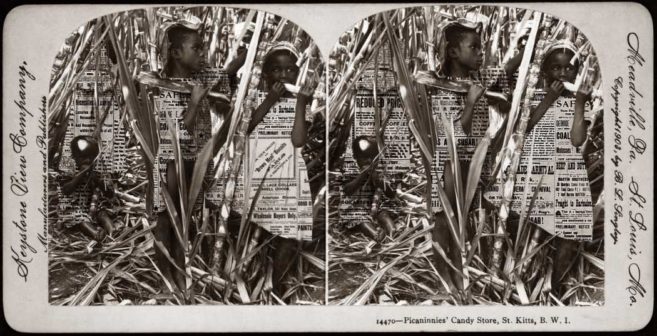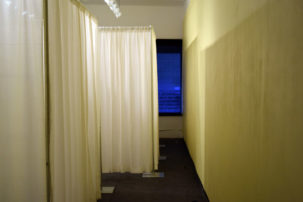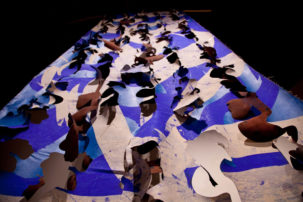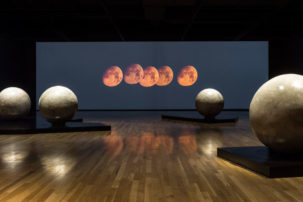The root of the word “translate” comes from transferre, which means to “carry over.” When I began this essay, I was thinking about what gets carried over through lineage, and how that becomes a site of return for how we translate our experiences. Language gets carried over. To think through translation is to grapple with the forces at play that condition access to language. For example, my relationship to English is fraught specifically because of my immigrant experience as a child. Learning English was a simultaneous process of erasure and assimilation. In coming to this place, what is currently called Canada, the language I knew was Arabic. I fell fast into a disciplined process of forgetting. Because of shame and stigma around not speaking English correctly, and in order to assimilate faster, I refused to speak Arabic. Articulation is something more than just using language to get at the truth of experience; in my case, those articulations were marked by forced displacement through many generations, and by not ever belonging to a place.
I often return to a quote by the poet and writer M. NourbeSe Philip in “Interview with an Empire,” where she describes a writer’s challenge with language: “The struggle is to reduce the gap between the experience and the expression of that experience.” I find it hard to think of language as a site to which my body belongs. I don’t feel like I belong to English; I no longer feel like I belong to my first language, either. My own discomfort and difficulty with language haunts my sense of belonging to the lands of Palestine, a place to which I have yet to return. In a conversation about this with Philip, she told me, “It’s not just about where you come from but where you are. Because I think where you be or are in language is where you be or are.”
Learning English and experiencing the difficulty associated with its structure and mechanisms made me realize that learning this language is not just about getting it right, but about understanding when it fails, when it limits thinking, and when it just has no words for what it is that I might be feeling or experiencing. The feeling of longing, love, hardline commitment, and unquestionable loyalty to my land (even though I’ve never been) marks my interest in thinking with images as a way out of the limits of language. My point of departure for everything stems from this feeling of unconditional love and tenderness for Palestine. “Where I be,” then, is always in Palestine, but through my relation to its images. My relationship to my land, my desire and longing for my land, surpasses the constraints of the English language. Instead, I look to images to find other ways of articulating this desire. The process of translating this desire into expression is determined by my love for the image and its capacity to bring me closer to my land.
If images are calling us through a fog or a cloud, it’s because at times they get at the limit of something before we can even speak it or write it. Instead they allow us to feel it.
These days I am learning from multimedia artists Ruanne Abou-Rahme and Basel Abbas. With sound, film, video, installation and performance, the collaborative duo produces multilayered, immersive environments inspired by their research process. Their most recent work, And yet my mask is powerful (2016–18), is a two-part project consisting of a five-channel video projection and an installation of objects. Abou-Rahme and Abbas were inspired by neolithic masks found during an archaeological dig in the areas around Hebron and Jericho in Palestine. To celebrate the find, the Israel Museum displayed these masks, some belonging to private collections around the world, as part of a large exhibition. Because of how inaccessible the museum is for many Palestinians, and because so many of these masks are now in the hands of collectors, Abou-Rahme and Abbas made copies of them using a 3-D printer and then featured them in the videos and installation.
And yet my mask is powerful, which takes its title from a line in an Adrienne Rich poem titled “Diving into the Wreck,” was inspired by young Palestinians returning to sites of destroyed, and now occupied, Palestinian villages. In their video, the artists honour these returns by making the journey back to these disappeared places. In past video work, Abou-Rahme and Abbas often feature figures on screen who remain anonymous, their faces never seen. In this case, a group of young Palestinians take turns wearing a mask as they walk through a landscape thick in overgrown vegetation, gazing at plants and touching an aged cactus (a plant historically grown to demarcate Palestinian villages). Some just look out onto the land, trekking through to get to the ruin or site of disappearance. “What was most striking in the returns of these young Palestinians,” say Abou-Rahme and Abbas in a recent conversation for Ocula, “…was the ways in which they were re-conceptualising and re-activating the idea of return. Something unexpected happens in these contemporary returns.”
This return is activated in the present. The right of return that Palestinians fight for, organize around and dream of is re-envisioned here as part of a present-day sojourn. To return now, and again and again, to the land of which we belong is not merely imagined from within the discourse of the colonial state but in defiance of its logic and language. In these journeys, the return is always possible, always being done. The moving images that Abou-Rahme and Abbas create in collaboration with these young Palestinians break from the fortified grip colonial forces have on the narrative of return. That “right of” is already had by us, Palestinians. We’re not asking or waiting; we’re returning.
In this work, these imaginings by way of a journey open up a space to see territory liberated from the clutches of colonial borders. Land here is not to be settled or occupied, but rather tended to, listened to, watched over and protected. For young Palestinians, the return to these sites means to return land to earth. This return, the one I am experiencing on screen, releases me, even if for a few minutes, from the violent history that conditions this separation of body from land, and land from earth. In the video, once they reach the site, it’s almost as if the future is drawn into the present. Some sit down on the grass, looking ahead in daydream, the ruin of an old village around them, maybe thinking of the possibilities for the new life to come, thinking of the life that is already here, and the life that has been, the foliage, the cacti, all the trees and plants, the soil that survived the violence and wreckage of occupation. Where I be and where I am in language is by way of the image. In an interview for BOMB Magazine, artist and poet Etel Adnan says, “Images are not still. They are moving things. They come, they go, they disappear, they approach, they recede, and they are not even visual—ultimately, they are pure feeling. They’re like something that calls you through a fog or a cloud.” And yet my mask is powerful tells me a story about the return as endless possibility. These images translate the longing for land through the contemporary returns of young Palestinians who visit, honour and care for the places that once were, revitalizing their historical roots through touch, presence and ritual, tending them for others to come. Re-conceptualizing the return opens up language around it and reveals, or makes possible, expressions of longing and action that were once unspeakable and unreachable. If images are calling us through a fog or a cloud, it’s because at times they get at the limit of something before we can even speak it or write it. Instead they allow us to feel it: the truth of desire appears for our eyes.
 Kandis Friesen, Dushanbe (still), 2018. Colour, stereo sound, HD video and stop-motion animation, 5 min.
Kandis Friesen, Dushanbe (still), 2018. Colour, stereo sound, HD video and stop-motion animation, 5 min.
These days I am also learning from Kandis Friesen’s videos. Friesen is a multimedia artist who works in sound, video, sculpture, performance, drawing and animation. She’s a builder, and an image-maker, as well as a musician and a trained technician. I have followed her work for quite some time because of the way her practice complicates diasporic identity and experiences of exile. Exploring Russian Mennonite, Ukrainian and former Soviet geographies, Friesen’s work grapples with the process of translation—what it is, what it does, how it functions. In her care, translation is not a tool or apparatus that merely activates access to another language, but a spatial and experiential formation where desire for a home long gone withstands the limitations of language. Friesen’s work engages this point of tension between language-as-homeland and its iterations in exilic ruminations. In her practice is a desire to be connected, a desire to be collective, and a desire for familial lineage.
As she writes, “This is always in context of the ethos of the saying Dee eensja Heimat fonne Menniste ess äahre Muttasproak—The only homeland for a Russian Mennonite is our mother tongue. Evolving from a radical movement across many territories (a kind of anarcho-communist Protestant Christianity that arose in the 16th century), Russian Mennonites are an inherently diasporic culture, with no particular homeland or place we are ‘from.’ The language then is the only thing that is portable, that can be taken with us—it becomes an audio territory, an aural nation, a collective geography that is invoked or created when we use our bodies as resonators, when we speak, sing, make noise, together or alone.”
Friesen’s work builds on relations: with loved ones, with family she meets for the first time, with language, with places, with songs, with structures and architectures. The intimacy in her practice revels in the mechanics of making; through the intense interrogation of form, something gets carried over. What seemed unspeakable now has space and appears as shapes, colours, sounds, as text, as image. Friesen creates images that re-translate the desire for homeland as something shaped by daily artistic rituals. The most compelling example of this is through a developing part of her practice, in which Friesen incorporates the stories of women in her family who, within their domestic sphere, are artists in their own right.
To The Nightingales (2017) and Dushanbe (2018) are part of an emerging video series “centered on the unrecognized art practices of women in [Friesen’s] family.” I feel the low bass frequencies in the soundscape of To The Nightingales all through my body. The intensity is gripping and pushes me to anticipate the image to come: flowers in a saturated, pinkish tone, growing wild on a bush. Text appears on screen that recounts how her grandmother grew millions of flowers, which she collected and pressed as leaves. I watch close-ups of flowers swaying with the wind and learn more about Friesen’s grandmother’s skills as a builder and a collector. “Colour was an intimate material,” one of the lines of text reads before images of more flowers, deep pink this time, crowded onto a lush bush. “Is it nostalgic, she would ask…to bring anything back from the dead…it is impossible, she would answer.” A minute later, speckled, out-of-focus, star-like reworks dissolve like apparitions into an image of a golden sliver of moon.
In Dushanbe a layering of light and shadow illuminates folds and fissures, and at times resembles translucent curtains over a window. In fact, the images are family photographs woven across the glass plates of a flatbed scanner and a backlit animation stand, threading together the artist’s own familial narratives of “exile, displacement, and profound joy.” Text appears over the images, recounting the story of Friesen meeting her great aunt for the first time in her tiny apartment filled with paintings of mountains, in a small town in Germany: “They’re spread out and hung at strange heights…she talks about the valley that holds Dushanbe…she misses the mountains…like their bodies were not separate, but now are.” While these images are not of Palestine, and Friesen is not Palestinian, I look to her work as an example of how translating desire for a homeland culminates in a poetic and aesthetic imagining that is not necessarily linguistic but material, cosmological, physical, intergenerational, experiential and unspeakable.
I read these two works as visual poems that animate the process in which Friesen engages translation as something “always in tandem with transposition (shifting something to another register) and transcription (making something into a mark, line, or gesture).” Friesen not only creates space in which she can showcase, and honour, the artistic talents of the women in her family, but also translates the experiences of intimacy, domesticity and familial history, as they’re expressed aesthetically and poetically, into the ritual and routine of every day.
In the works of these artists, there is a tenderness at play between language and image. In thinking with them, I see how various interlocked formations might become undone through the process of translation, a process that allows for a different kind of encounter with land, home and place: one that is imagined and experienced outside of colonial time and space, outside the enclosures of a language with which I often find myself at odds. Art is not separate or alienated from how we live through the day—rather, it saturates the experience of what makes the day a day.

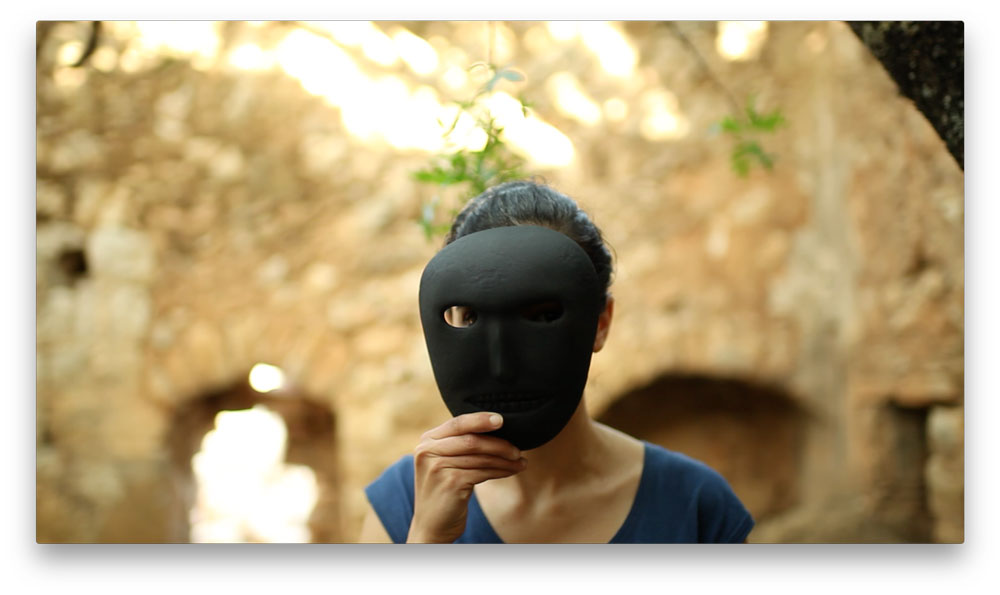 Ruanne Abou-Rahme and Basel Abbas, And yet my mask is powerful, Part 1 (still), 2016–18. Five-channel video projection, two-channel sound, subwoofer, tools, bricks
and boards
. 8 min 44 sec; dimensions variable. Courtesy the artists.
Ruanne Abou-Rahme and Basel Abbas, And yet my mask is powerful, Part 1 (still), 2016–18. Five-channel video projection, two-channel sound, subwoofer, tools, bricks
and boards
. 8 min 44 sec; dimensions variable. Courtesy the artists.
